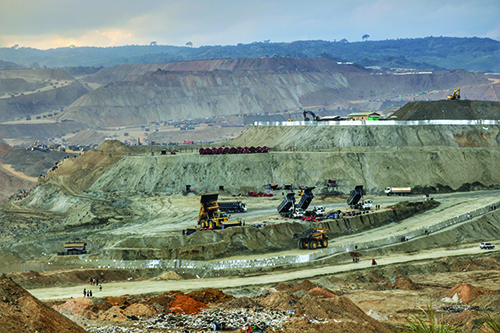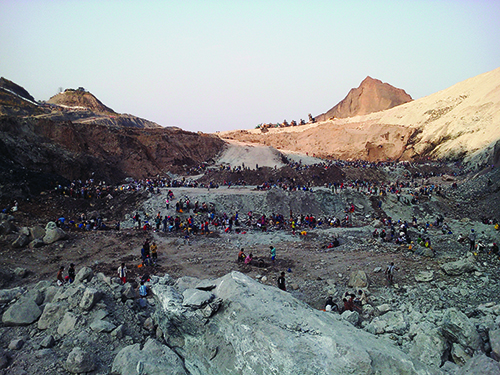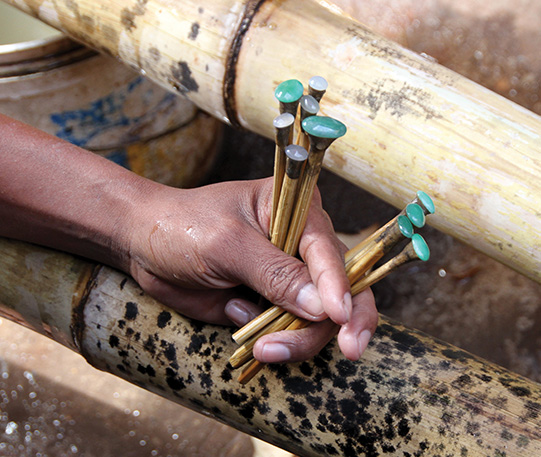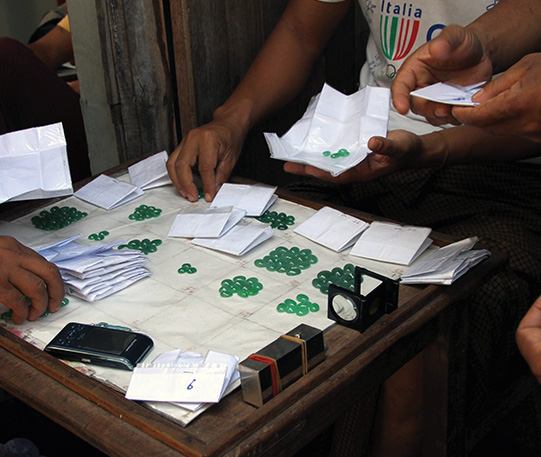
Editor’s Note: This is the second part of a two-part series about the past and present jade mining industry in Myanmar, formerly Burma, Asia. Be sure to enjoy Part I>>>
By Steve Voynick
In 1969, Burma’s military government tightened its control and banned private gemstone mining. But with the government unable to control Kachin State, private mining continued in Hpakan, where a black market funneled the jadeite to Thailand and Hong Kong.
But then, following Chinese free-market reforms and the decline of the Maoist culture in the 1980s, the Jade Road reopened, and Hpakan jadeite again began reaching the interior of China.
In 1988, an even more repressive military government took power and changed Burma’s name to Myanmar, a derivative of the ancient regional name Mranma. Four years later, it negotiated a cease-fire with the KIO and legalized private jade mining. Unfortunately, mining licenses were awarded only to a few well-connected military and political figures.
This arrangement, which would further enrich these already-wealthy mine owners and do nothing to benefit the nation, led to development of large, highly mechanized, open-pit mines. Heavy equipment of Chinese and American manufacture could not dig through hundreds of feet of conglomerate to search for jadeite. Jadeite production increased dramatically, but the huge, unregulated mines became environmental disasters.
While efficient at high-volume earth moving, these mines are inefficient at identifying and recovering jadeite. Substantial amounts of jadeite therefore end up in ever-growing waste dumps that have become a magnet for hordes of unlicensed, artisanal miners.
An estimated 12,000 artisanal miners currently eke out a subsistence living by finding and selling pieces of discarded jadeite. Risking capture by government military patrols and armed mine-security forces, these miners survive on poor diets in ramshackle settlements of lean-to shelters that lack sanitation facilities. Many cope with these abysmal conditions through the regular use of opium.

Realistically, the miners hope to find pieces of mid-quality jadeite to pay for several more months of searching the dumps. But their ultimate goal is to find even a small piece of top-quality jadeite that can be sold for $1,000 or more—a small fortune for hand-to-mouth artisanal miners with no other employment opportunities.
The steep mine dumps rise as high 400 feet above the bottom of the open pits and are extremely dangerous. Loaded from the top by huge ore-haulage trucks, the dumps stand at the limits of geological competence. Continuous dumping operations, digging by artisanal miners, and a long rainy season contribute to their instability.
In the last eight years, more than 1,000 miners have died in dump landslides with many more seriously injured. In 2015, a dump landslide killed 130 artisanal miners; three more landslides since have each killed at least 50 others. Nevertheless, soaring jade prices continue to lure more artisanal miners than ever to the dangerous dumps.
Global Appeal
Driven by strong Chinese buying, jade prices had begun climbing rapidly in the 1990s. To take advantage of the booming jadeite trade, the prestigious international auction houses Christie’s and Sotheby’s opened Hong Kong offices.
In 1997, Christie’s auctioned the legendary “Doubly Fortunate” necklace of 65 stunning half-inch-diameter jadeite beads. The necklace’s name came from the original owner of the rough from which the beads were cut, who reportedly encountered only higher grades of jadeite each time he cut the stone, thus “doubling his fortune.” The necklace sold for an astounding $9.39 million, then an all-time record for jade, but one that would soon be broken.
By 2005, the big Hpakan mines were collectively accruing annual profits of a half-billion dollars. The United States Congress, concerned over the governmental corruption and human-rights abuses that plagued Hpakan jadeite mining, passed a 2008 act that limited the importation of Myanmar jadeite (and rubies) to hopefully curtail the profits of Myanmar’s mine owners. But this now-rescinded act had little effect, and the open-pit profits soon reached $1 billion per year. Today, the collective, annual profits of Myanmar’s open-pit jadeite mines are estimated to top $2 billion.
Of the 30,000 tons of jadeite now mined annually in the Hpakan Jade Tract, only a fraction of one percent is “imperial” jade—the highest grade. Sold by the gram, imperial jade has seven sub-grades, all used exclusively for high-end jewelry.

Four percent of Hpakan’s production is “commercial” jade. Selling for about $500 per pound in the rough, it is fashioned into fine carvings and mid-priced bangles. Bangles are one-piece (hololithic, or “whole-stone”) circular forms worn as bracelets and earrings. As a classic style of Chinese jade carving, bangles symbolize unity and eternity.
Most of Hpakan’s production is “utility” jade, material that is flawed by poor color, lack of translucency, or inclusions. Selling for $20 to $80 per pound, it is often bleached or dyed to enhance its color and made into inlay pieces, mass-market carvings, and inexpensive jewelry.
Imperial jade’s emerald-green color is caused by traces of divalent chromium. Less-desirable, “grassy”-green colors are due to divalent or trivalent iron; a mix of these iron chromophores creates bluish-green and bluish-black colors. Reddish-brown or dark-green staining, usually within fissures, is due to iron oxides and hydroxides, mainly hematite. Depending upon appearance, iron staining may or may not be an asset in determining value.
Traces of manganese create jadeite’s lavender colors, with variations due to the presence of vanadium and nickel chromophores. Subtle gray-to-black streaking is caused by graphite. Multicolored jadeite, usually green-white, green-lavender, lavender-white, or green-lavender-white, is created when chemically different hydrothermal fluids partially mix prior to solidification. White jadeite contains no chromophoric agents at all.
Determining Grade
Jadeite grade is determined by a complex combination of color type and quality, translucency, tone, and clarity. Most prized is a clean, emerald green color with no hints of yellow or blue. Also desirable are soft, rich, lavender colors with no blue or pink overtones. Color distribution in green or lavender jadeite should be even, with little or no zoning. The inherent zoning of multicolored jadeite should exhibit subtle, cloud-like swirls. Color saturation refers to color intensity, with thin or “watery” colors least desirable.
In fine jadeite, translucency is no less important than color. The top grades are highly translucent and may even approach semitransparency, transmitting and reflecting light with a soft glow.
Tone refers to darkness or lightness; the finest jade exhibits a mid-range balance. Fine jade also has excellent clarity with no fissures or obvious inclusions.
Rough Hpakan jadeite is sold in markets in Hpakan, Myitkyina, Lonkin, Moquang, Mandalay, and Yongon (formerly Rangoon), mainly to Chinese buyers for resale in the interior of China, Hong Kong, or Thailand. The largest Myanmar market is in Mandalay, where trade is wryly reported to be based on the “green, red, and white commodities”—green (jadeite); red (Burmese rubies from Mogok); and white (opium).

Buying and selling rough jadeite in these markets demands both experience and luck. Because commercial-grade exteriors may conceal imperial-grade interiors and vice versa, evaluating rough jadeite is tricky. Dealers grind small “windows” through the exterior rind of the rough, then use bright LED or xenon penlights to reveal the basic color and translucency of the interior jadeite.
Considering the current value of fine jade, fakery is inevitable, not so much in the Myanmar markets but in the global retailing of finished jade jewelry and carvings. Among the many jade simulants are chrysoprase, the green gem variety of microcrystalline quartz; natural green or lavender fluorite; dyed calcite; colored glass; and plastic. Jade is routinely waxed to enhance its luster, an acceptable treatment that is not considered an alteration.
Apart from jadeite, the Hpakan Jade Tract’s only other collectible mineral is bright-green Maw Sit Sit, also called “albite jade” and “chromian jade.” Named for its source, a village in the Jade Tract, Maw Sit Sit is a rock consisting mainly of the pyroxene mineral kosmochlor (sodium chromium silicate) and lesser amounts of chromium-enriched jadeite and albite. Kosmochlor creates Maw Sit Sit’s distinctive bright-green color. Opaque and fashioned into cabochons and carvings, Maw Sit Sit is sometimes passed off as jadeite.
The real treasure of the Hpakan Jade Tract, of course, is the world’s best jadeite, and its prices continue to set records. Top-quality, imperial-jade bangles 55 millimeters in diameter and weighing 60 grams now sell for upwards of $1 million—roughly $16,000 per gram.
Gemologist and author Richard Hughes was right 25 years ago when he described the Hpakan jade trade as having only a few winners and many losers. And his assessment still holds true today. Although the prices and production of Burmese jadeite are soaring, the winners are still only a handful of wealthy mine owners, while the many losers include the nation of Myanmar and the thousands of artisanal miners who hope desperately to find even a small piece of imperial jade.
If you enjoyed what you’ve read here we invite you to consider signing up for the FREE Rock & Gem weekly newsletter. Learn more>>>
In addition, we invite you to consider subscribing to Rock & Gem magazine. The cost for a one-year U.S. subscription (12 issues) is $29.95. Learn more >>>


 Hide i
Hide i












